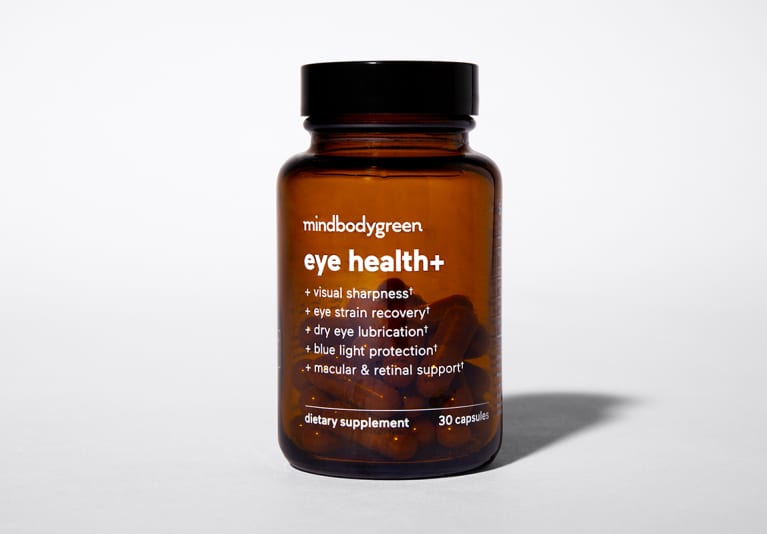
October 6, 2022 — 19:01 PM
When most people talk about being overworked, they’re often referring to the body and mind. But what about the eyes? Or, more specifically, the eye muscles?
After all, visual burnout is a real consequence of today’s digital world, and it can contribute to your feelings of strain and fatigue. Ahead, discover if your eyes are being overworked, plus ways you can focus (pun intended) on eye health.
Eye strain, or eye fatigue, is a generic term to describe tired eyes. For most folks, it’s caused by looking at screens too much without any breaks; but you can develop eye strain after any intense use of the eyes (i.e., prolonged driving time, lack of quality of sleep, or reading too long).
eye health+
Visual performance support for the digital age*

When it’s due to extended screen use, it’s known as digital eye strain or digital eye fatigue. In fact, between remote work and the rise of digital devices, this is most likely what you’re experiencing when you have eye discomfort.
So, how does eye strain happen, exactly? It comes down to the ciliary muscles in your eyes. Don’t underestimate these tiny muscle. They control your lens, allowing you to focus on objects at different distances.
“When we focus on objects more than 20 feet away, the ciliary muscles relax and the lens flattens out,” explains Karen Hecht, Ph.D., scientific affairs manager at AstaReal®. But when we focus on objects up close (i.e., less than 20 feet away), the ciliary muscles contract to round the lens, she says.
Thus, when you’re focusing on close objects (like a screen) for hours on end, your ciliary muscles are contracting, or flexing, for a long time. “It’s like holding a plank or squatting for hours, the burn will be real,” explains mbg’s vice president of scientific affairs Ashley Jordan Ferira, Ph.D., RDN. This prolonged contraction for near focus activities essentially burns out your ciliary muscles, resulting in eye strain.
Signs you’re overworking your eyes.
As Jeffrey Anshel O.D., FAAO, optometrist and author of What You Must Know About Eyestrain, tells mbg: “Eye strain can occur at any age to anyone.” However, you might be more likely to experience tired eyes if you work on the computer all day, watch a lot of TV, or spend many hours gaming or looking at your phone screen.
The degree of eye strain (and how it actually feels) depends on several factors, including what you’re doing to tire out your eyes and your “baseline” eye health, says Anshel. That said, everyone has a unique description of what eye strain feels like, he explains.
Some clues of overworked eyes include:
- Eye or head discomfort
- Tired eyes (i.e., struggling to keep your eyes open)
- Difficulty concentrating
- Eye dryness from reduced blinking
How to proactively care for your eye muscles.
If you’re regularly experiencing visual burnout, it might be time to nurture your ciliary muscles. Fortunately, there are several ways to do just that in the name of proactive eye care.
One strategy is to take a premium, comprehensive vision supplement like mbg’s eye health+. This vegan eye health formula provides 360-degree, plant-powered support for visual performance by delivering five powerhouse botanical bioactives: Lutein and zeaxanthin, two important carotenoids for photostress recovery and blue light protection; Patagonian maqui berry for eye hydration; saffron flower for retinal health and visual function; and astaxanthin, an carotenoid that helps eyes focus so they can recover and reset.*
Specifically, “astaxanthin is the ‘front of shop’ carotenoid here doing most of the heavy lifting in this area of eye muscles and our lens flex,” says Ferira.
What’s more, astaxanthin has been clinically shown to increase retinal blood flow, which is essential for meeting the high energy requirements of the visual system.* Hecht explains further: “The harder we work our eyes, the more blood flow is needed to support their energy demands. [But] as we age, blood flow becomes less efficient, which can lead to an energy deficit.”
Astaxanthin as AstaReal® (the sustainably-sourced form of astaxanthin found in mbg’s eye health+) can help: Clinical studies have found that regular computer users have reported less eye strain after supplementation with AstaReal®.*
Other tips for nurturing ciliary muscles and eye health include:
- Eating foods rich in lutein and zeaxanthin. According to Anshel, these carotenoids accumulate in the retina to provide protection from blue light. “Both are found in kale, broccoli, spinach, egg yolks, and other deeply colored veggies,” says Anshel.
- Using the 20-20-20 rule. When using a screen, let your eyes rest using the 20-20-20 rule, which was developed by Anshel. It involves looking 20 feet away for 20 seconds every 20 minutes.
- Getting routine eye checkups. Whether or not you wear glasses, regular visits to an eye care professional (once a year, for most people) will ensure your eye health is up to par. (And if you do wear glasses, routine exams will keep your prescription up to date, which is essential for minimizing eye strain.)
In today’s digital world, proactive eye care is more important than ever. Start by eating plenty of colorful veggies, resting your eyes when using screens, and getting regular eye exams.
To bolster visual performance and longevity in a targeted way, you can also add a premium eye health supplement like mbg’s eye health+ to your daily wellness routine.* Featuring a rainbow of plant-powered phytonutrients, this revolutionary formula is designed to provide daily, comprehensive eye function support from the inside out.*
If you are pregnant, breastfeeding, or taking medications, consult with your doctor before starting a supplement routine. It is always optimal to consult with a health care provider when considering what supplements are right for you.

eye health+
Visual performance support for the digital age*
eye health+
Visual performance support for the digital age*


